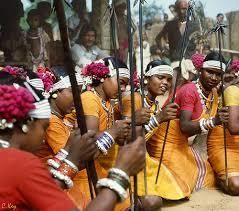GPSC (Goa) Exam > GPSC (Goa) Notes > Goa State PSC (GPSC) Preparation > Goa: Schedule Tribes
Goa: Schedule Tribes | Goa State PSC (GPSC) Preparation - GPSC (Goa) PDF Download
Scheduled Tribes of Goa

- Primary Tribes: The main tribes of Goa, including the Gawda, Kunbi, and Velip, are believed to be the original settlers of the region. Reconstructing their early history is challenging due to the lack of written records, but evidence from archaeology, literature, and folklore suggests that these tribes are indigenous to Goa.
- Ethnic Background: It is believed that the Goan tribes belong to the proto-Australoid racial group. These tribes are also referred to as Mull Goenkar, meaning "native people" or the original settlers of the land.
- Colonial Impact: During the colonial period, the tribal population faced both external and internal challenges. Despite this, the tribes played a significant role in Goa's political, economic, and social development, although this aspect of Goa's history remains underexplored.
- Historical and Cultural Significance: Goa, despite being one of India's smallest states, has a unique charm that attracts visitors. Its cultural heritage is deeply rooted in both its historical timeline and geographical context. Goa's distinctive identity has long been recognized, with references found in ancient manuscripts documenting trade routes along the Konkan coast.
- References in Hindu Epics: Goa is mentioned in the Hindu epic, the Mahabharata, where it is referred to as Goparashtra, meaning the "country of cowherds," indicating its historical significance and presence in ancient times.
- Tourist Appeal: Goa, renowned for its sandy beaches, blue seas, and clear skies, is an ideal vacation destination. It offers numerous activities and attractions for visitors to enjoy.
- Welcoming Locals: The people of Goa are known for their warmth, friendliness, and hospitality. They greet tourists from around the world with open arms and an inviting attitude.
- Tribal Heritage: Goa’s population includes descendants of various ancient tribes, who continue to thrive in the region. These tribes are a vital part of Goa's cultural heritage.
- Chief Tribes: The main tribes of Goa include the Velips, Kunbis, Gowdas, and Dhangars.
- Preservation of Traditions: Tribal communities in Goa have largely maintained their traditional lifestyles, practices, and customs. Despite being aware of global developments, they have chosen to stay connected to their cultural roots.
Gowdas Scheduled Tribes of Goa
- Tribal Location: The Gowdas are a prominent tribe residing in the interior villages of Goa. There is no official documentation detailing their migration history to Goa.
- Religion and Worship: The Gowda tribe practices Hinduism and worships Lord Malikkarjun, a form of Lord Shiva.
- Cultural Practices: The Gowdas are strict about maintaining their lineage and ethnicity. Inter-tribal marriages are prohibited, and they strictly adhere to this practice. However, they permit cross-cousin marriages between maternal and paternal cousins.
- Impact of Colonialism: During the Portuguese colonial period, part of the Gowda community was converted to Christianity, leading to the division of the tribe into three distinct groups.
- Funeral Customs: Unlike traditional Hindu customs of cremation, the Gowdas bury their dead in a designated burial site.
- Women’s Rights: Gowda women have significant rights within their community. They can participate in economic activities, including agriculture, and are entitled to inherit their husband’s property upon his death.
Kunbis Scheduled Tribes of Goa
- Origins and Characteristics: The Kunbis are considered one of the original tribes of Goa. They are known for their diligence and strong connection to nature, working tirelessly to make a living.
- Religious Transition: Historically Hindu, many Kunbis were converted to Christianity by the Portuguese.
- Cultural Significance: The Kunbi people are renowned for their traditional dance, which is a celebrated aspect of Goan culture.
- Settlement: The Kunbis predominantly reside in the Salcete taluka of Goa. They are known for their simplicity and adherence to traditional customs.
- Lifestyle: Kunbis lead a simple life, living in modest mud-walled huts with bamboo roofs covered in coconut leaves or straw. They are known for their close-knit family structures and communal living, referred to as 'kutumba,' derived from the Sanskrit word 'kutumbakam,' meaning family.
- Cultural Traditions: The Kunbis maintain a rich tradition of art and culture. Their songs are melodious, and their dances are vibrant. The spring festival of Shigmotsav, held in February-March, is a major cultural event where you can experience their elaborate and choreographed celebrations, showcasing various folk themes through the streets.
Question for Goa: Schedule TribesTry yourself: Which tribe in Goa prohibits inter-tribal marriages but allows cross-cousin marriages between maternal and paternal cousins?View Solution
Velips Scheduled Tribes of Goa

- Historical Roots: The Velips are considered a sub-caste of the Kunbis, with their origins tracing back to ancient times. Archaeological evidence from a recently discovered Stone Age site at Kajur suggests that their practices are inspired by prehistoric traditions.
- Distinct Features: Despite sharing some similarities with the Kunbis, the Velips have distinct customs, rituals, and racial characteristics that set them apart.
- Surname Significance:
- Gaonkar: Refers to ancestors who settled in a Goan village. The term ‘Gaonkar’ is derived from the Sanskrit word ‘Gaon,’ meaning village.
- Zarkar: Derived from ‘Zara,’ meaning fountain, indicating ancestral origins near a water source.
- Dahikar: Comes from ‘Dahi,’ meaning yoghurt, possibly indicating a historical connection to dairy production.
- Family and Economic Stability: The Velips are known for their adherence to the joint family system, which fosters strong family bonds. Economically, they are more stable compared to some other tribal groups.
Dhangers Scheduled Tribes of Goa
- Occupation: The Dhangars are primarily shepherds, leading a semi-nomadic lifestyle.
- Legend: They are believed to have originated from the dust of Lord Shiva's body.
- Distinct Appearance: They are easily recognizable by their traditional dress and occupation.
- Grazing Practices: When grazing their oxen, they carry a stick and are accompanied by one or two hunting dogs.
- Marriage Customs: Polygamy is common, and brides are often purchased with money or goods.
Religion of Scheduled Tribes of Goa
- Religious Practices: The majority of the Gawda, Kunbi, and Velip communities practice Hinduism and Christianity. Over the past 500 years, many from these tribes in Goa have converted to Catholicism.
- Historical Worship: Traditionally, these tribes worshipped Ant-hill and did not idolize deities. However, over time, they adopted the worship of their own deities and incorporated elements of Catholicism.
- Tribal Identity: Despite conversions, tribal communities in Goa have maintained their traditional customs, cultural practices, and tribal rules.
- Historical Conversion: In the 17th century, Christian missionaries forcibly converted some Gawda tribes. Despite this, Catholic Gawdas continue to uphold their traditional customs and rules.
- Early Settlers: The tribes are considered the original settlers of Goa, contributing to the region’s development through systems like the Gavapon or Gaounkari.
- Gaonkary System: The Gaonkary System, or Communidade, is an ancient cooperative rural establishment in Goa. This system focuses on improving agricultural productivity, managing land, and maintaining irrigation canals.
Question for Goa: Schedule TribesTry yourself: Which Scheduled Tribe in Goa is primarily known for their occupation as shepherds?View Solution
The document Goa: Schedule Tribes | Goa State PSC (GPSC) Preparation - GPSC (Goa) is a part of the GPSC (Goa) Course Goa State PSC (GPSC) Preparation.
All you need of GPSC (Goa) at this link: GPSC (Goa)
FAQs on Goa: Schedule Tribes - Goa State PSC (GPSC) Preparation - GPSC (Goa)
| 1. What are the major Scheduled Tribes of Goa? |  |
Ans. The major Scheduled Tribes of Goa include Gowdas, Kunbis, Velips, and Dhangers.
| 2. How many Scheduled Tribes are recognized in Goa? |  |
Ans. Goa recognizes a total of four Scheduled Tribes.
| 3. What is the predominant religion among the Scheduled Tribes of Goa? |  |
Ans. The predominant religion among the Scheduled Tribes of Goa is Hinduism.
| 4. Are there any specific government provisions or schemes for the Scheduled Tribes of Goa? |  |
Ans. Yes, the Goan government provides various provisions and schemes for the welfare and development of the Scheduled Tribes in the state.
| 5. How are the Scheduled Tribes in Goa identified and classified? |  |
Ans. The Scheduled Tribes in Goa are identified and classified based on specific criteria such as social and economic status, cultural practices, and historical background.
Related Searches




















